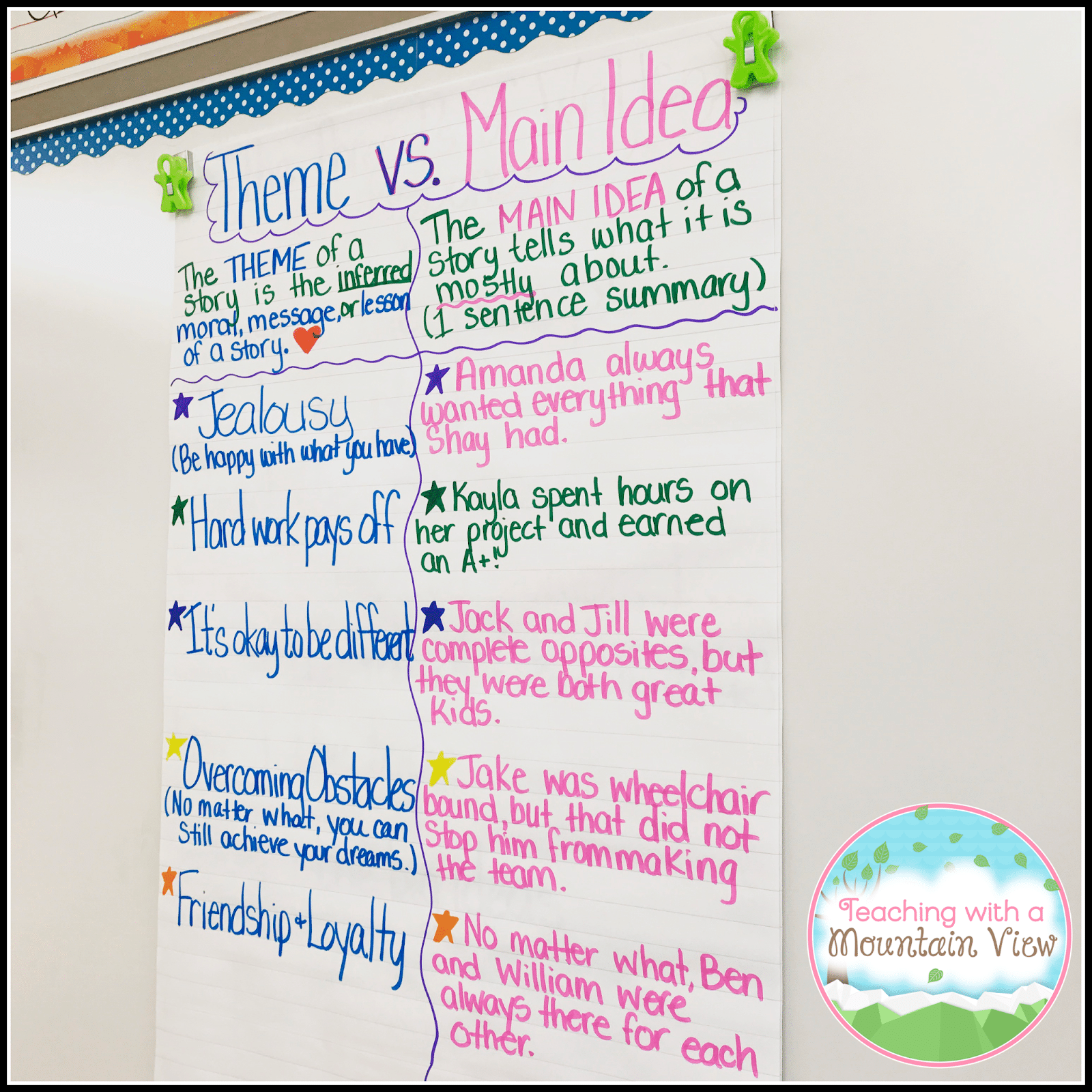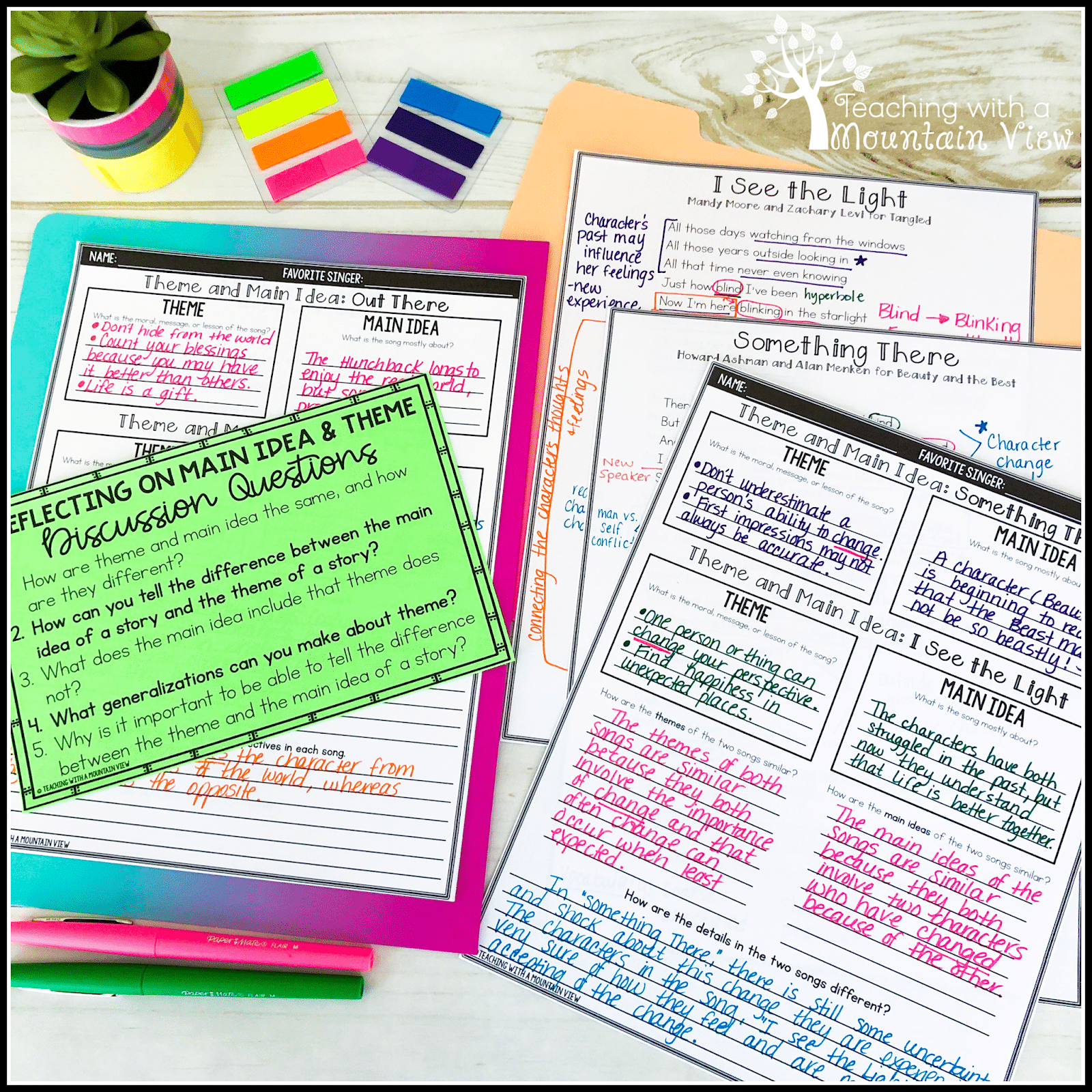Determining the main idea and/or theme of a text are critical reading comprehension skills. While it may seem like main idea is a pretty simple skill for upper elementary, once you start digging into the complexities of adding theme as well, it can get tricky! I’ve learned that teaching main idea and theme in unison can help students discern the difference between the terms.

Download Everything You Need– for free!
This free PDF guide will allow you to have all of the main idea and theme resources right at your fingertips. It's packed with checklists, book lists, lesson plans, anchor charts, practice activities, and more!
Important Main Idea and Theme Vocabulary
Note: There is a great deal of conversation about the proper use of the terms main idea and central idea. Some scholarly articles refer to main idea as being used only for informational texts. Others refer to it being used for both fictional and informational texts. For the purpose of this guide, main idea and central idea are used interchangeably to mean the big idea of the text, whether it is fiction or informational text. I introduce both terms to my students.
Here are a few key terms to cover:
- Theme: The message or lesson
- Main Idea: What the story/text is mostly about
- Key Details: Events or information that support the main idea.
- Topic: The subject of the text
- Recount: Retelling the story/text in your own words
- Summarize: A more formal retelling of the main points and key details of a text in your own words.
Main Idea and Theme Lesson
For 3rd Grade, this lesson is usually done after students have been introduced to main idea and theme independently. If you are teaching grades 4+, this works well as an introduction to both topics.
Introduction and Hook
Begin by playing the song and/or video for Surface Pressure from Encanto (any Disney song works well for this lesson). Then, ask students to describe what was happening in the video. Write down all of their brainstorming. After they’ve listed out all the things that happened, ask them to describe, in ONE sentence, what the song is about. This will be the main idea of the song. Once we’ve determined the main idea, I ask them to brainstorm how Luisa is feeling, what message the song is sending, and what lesson can be learned from the song. This is our theme. Finally, I ask them to pair the theme down to ONE word. This is our topic. My students LOVED this activity, and it became very clear to them the difference between the three terms.
Anchor Chart
After we dissect Surface Pressure, we create the anchor chart together. I usually give them the themes, and then they generate a fictional main idea statement that would teach the theme. This is another chance to discuss the difference between theme and topic. Oftentimes, we are tempted to write the theme as one word, but in reality, it is usually at least a brief phrase or a sentence.

Read Aloud
At this point, I like to start Picture Book of the Day. I have compiled a list of books that are perfect for determining theme, and I highly recommend you read one each day as you’re teaching this skill. Create a chart where you determine the main idea, topic, and theme of each book. For grades 4+, add a column for students to write evidence of the theme on one color sticky note and evidence of the main idea on another.

I created an Amazon Affiliate List of my favorite main idea and theme picture books. The free PDF includes activity suggestions to use with some of the books to make teaching your lessons easier!
Flipbook
Now is the perfect time to use the free flipbook resource from your download. It serves as direct instruction, note taking, and critical practice for students.
Main Idea and Theme Sort
Now that students have had a decent amount of practice identifying theme and main idea, we move on to completing this short sort.

Main Idea and Theme Enrichment and Practice Activities
Just like we start our lesson with a clip from a Disney song and movie, I always incorporate a lyric dissection into our week of main idea vs. theme lessons. This lesson usually comes after we complete our flipbook together. We focus heavily on annotation and providing evidence to support our theme.
I consider these main idea vs. theme task cards an essential part of the lesson sequence, as it gives students a differentiated way to consider different themes and main ideas of texts.
Related Blog Posts
Related Resources
- Find the Theme Task Cards
- Teaching Theme and Topic
- Main Idea Game
- Main Idea Activity
- Main Idea Task Cards
- Theme Paired Passages
The post The Complete Guide to Teaching Main Idea and Theme appeared first on Teaching with a Mountain View.


